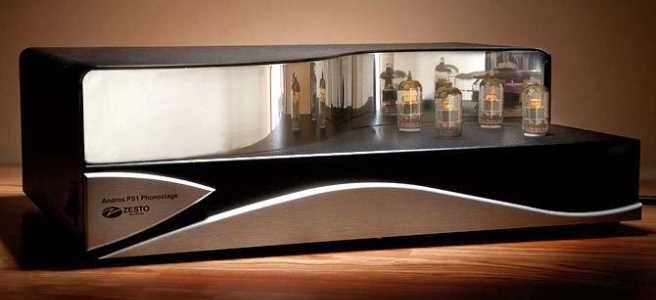Stereophile has again posted a link to J. Gordon Holt’s comprehensive audio glossary containing over 300 terms used by audio reviewers (and audiophiles) to...
Read More »
Recent Articles
Sounds Like? An Audio Glossary
Wilson Audio – A Culture of Craftsmanship
I recently had the pleasure of spending the day at the 50,000 square foot Wilson Audio facility in Provo, Utah, about an hour south...
Read More »
Recent Shows
T.H.E. Show (Newport Beach) 2013 Coverage
I know this isn’t going to win me any popularity contests, but it needs to be said. T.H.E. Show was a disappointment this year....
Read More »
CES 2013 Coverage
Both CES and T.H.E. Show were considerably smaller this year. There were one or perhaps two fewer floors at the Venetian, and by my...
Read More »
Recent Reviews
Meridian Director DAC Review
Since introducing the world’s first audiophile CD player in 1984, Meridian has been on a relentless mission of improving the sound of digital playback....
Read More »
Pass Labs INT-30A and INT-150 Integrated Amplifier Review
When choosing an amplifier, to paraphrase Hamlet, to Class A or to Class A/B, that is the question. There are ardent supporters of Class...
Read More »
Manufacturer Links
Zesto Andros PS1 Phono Stage Review
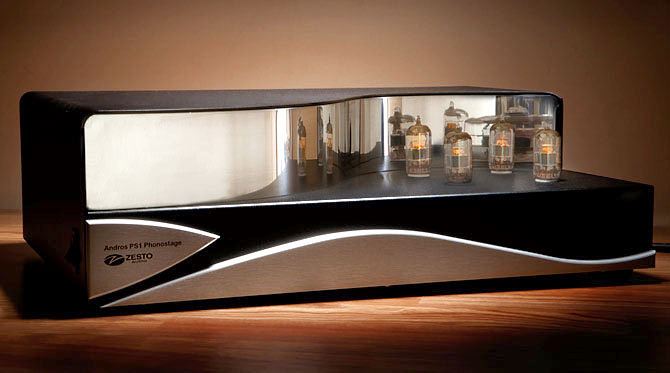
I first laid eyes on the Zesto Audio Andros PS1 phono stage ($4300) at RMAF 2011, where it was introduced in several rooms with little fanfare. I was immediately smitten with its distinctively curved, powdered-coated and chrome chassis, which I later learned was designed by the talented Carolyn Counnas, wife of Andros’s designer, George Counnas. What a tandem! But its beauty was more that skin deep, as its sound was smooth, detailed, warm, and inviting. It garnered special mention in my RMAF 2011 coverage. I have seen it at every subsequent trade show I have attended, always present in multiple rooms, and always receiving an enthusiastic reception. It has been a favorite of reviewers too, so I had to wait my turn for a review sample to become available. It was worth the wait.
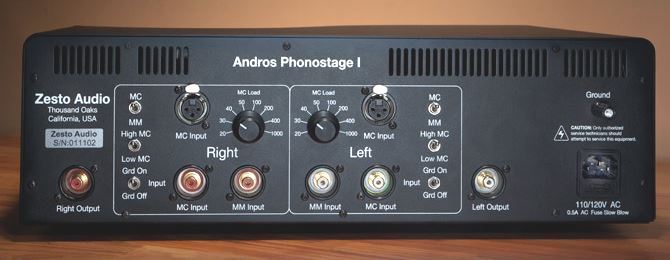
As noted, the front panel’s most striking feature is its curved chrome facade which shows off the four gold-pin ECC83S tubes to great advantage. The ECC83S is a variant of the common 12AX7, so tube rollers will be pleased that they can indulge their obsession to their heart’s content. I had to hunt around to find the power switch, which is tucked away on the left side panel. Because it is a dual-mono design, the rear panel of the Andros is laid out symmetrically, with duplicate inputs, outputs, switches and controls. There are separate inputs for MC and MM cartridges on unbalanced RCAs, as well as a pair of balanced MC inputs on XLRs. Switches select between the MC and MM inputs. Another set of switches, marked High MC/Low MC, select the taps on the internal step-up transformers to provide either 55dB or 65dB of gain. A third set of switches lifts the ground. There are rotary switches to select MC resistive loading, allowing you to select among 20, 30, 40, 50, 100, 200, 400 and 1000 ohms. MM resistive loading is fixed at 47k ohms. Finally, there is a binding post for ground, and a combination fuse holder and IEC power inlet, which feeds two internal linear regulated power supplies. Everything is well marked. As an added touch, the 20 pound weight of the Andros is supported by three Isonode footers to dampen vibrations. Unlike an increasing number of high-end components, the Andros is hand-made in the U.S.A., though some of its components are sourced from abroad. Speaking of components, George uses 1% metal film resistors in the design for close tolerances, and uses polypropylene capacitors throughout the signal path. The warranty is two years on the unit itself, with six months on the tubes.
Each unit is burned in at the factory for 50 hours. Since mine was a review unit and had made the rounds, it was well run-in. When I first inserted the Andros into my system in lieu of my modest reference Musical Surroundings Phonomena II, I immediately noticed a problem. There was hum and tube rush audible at the listening position at normal volume levels. Since my Phonomena II is dead silent, I began the detective work. I engaged the ground switches on the back of the Andros, which ameliorated the situation somewhat. I doubled-checked the ground wire from my turntable to the Andros and confirmed that it was firmly connected. I next replaced both the interconnects and the power cord, thinking one or the other might be the problem. No luck. After troubleshooting over the phone with George, we finally concluded that the unit must have been damaged in shipment, so I returned it. Once he had it back on the bench, George determined that the MC/MM switch for one channel, and three of the four tubes, were defective. UPS strikes again. He made the repairs and shipped the unit back to me with fresh set of tubes.
When I put the Andros back in the system, the tube rush was gone and the hum was down substantially. I checked the sensitivity setting on my preamplifier and saw that it was set to 1.4 volts rather than 2.0 volts. I changed it to the standard 2.0 volts and the hum was no longer audible at the listening position at normal volume levels. Further investigation revealed that the ground wire from the tonearm had become disconnected. Once reattached, the hum went away altogether. Nevertheless, if I turned the volume significantly beyond normal listening levels, tube rush was present. I think that is simply something endemic to tube components. Since it wasn’t audible at normal listening levels, no harm, no foul. For what its worth, noise is specified at -75dBu.
My cartridge is the medium output (1.0mV) version of the Dynavector 20X2. Although the KAB cartridge gain calculator indicates that for my cartridge 50dB of gain is optimum (325mV rms output at 5 cm/s at 1kHz), I found that the best dynamics came from setting the gain on the Andros to 65dB rather than 55dB. Although Dynavector specifies a resistive load of 500 ohms, I also found that the 400 ohms setting on the Andros provided the best high frequency performance. Although more detailed, it was a little too lean sounding at 1000 ohms, at least for my taste. If your loudspeakers are more forward sounding than mine, 200 ohms may be better still. It is important to listen to alternate settings before making your final selection. Listening trumps theory.
With trouble-shooting and setup behind me, I sat down to evaluate the Andros – for two months. What a pleasure! My experience with phono stages until now has been limited to the Phonomena II in my system and the Ayre P-5xe in the Ralston Listening Room system (VPI Classic 2 and Ayre/Bauer DPS turntables; Koetsu Coralstone, Miyajima Shilabe and Mono BE cartridges). I obviously claim no special expertise, but approached the review as a learning experience, much as any audiophile would have when moving up from his present phono stage to something better, and, in this case, finding out what tubes have to offer. I relied on the Phonomena II exclusively for comparison. I did, however, listen to a significant portion of the 200+ records in my fledgling vinyl collection. Let me give you a couple of examples of what I heard.
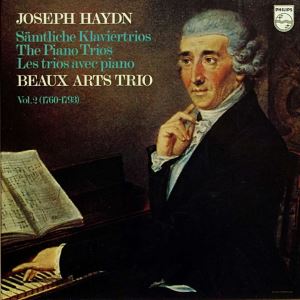
Let’s start with Haydn’s Piano Trio in C, No. C1 performed by the Beaux Arts Trio on a Philips pressing. The first thing that struck me was the utter coherence of the soundstage. There was no spotlighting of instruments; rather the trio spread out before me unconstrained by the location of my loudspeakers, which simply disappeared. The piano began the allegro moderato first movement, and was portrayed in exactly the right size. Manahem Pressler evoked a beautiful piano tone, with resonate left hand notes and right hand notes which had tremendous decay, as if a halo surrounded them. He was joined by Isidore Cohen, on a most natural sounding violin with a lovely sheen to the strings. Bernard Greenhouse’s cello did not draw attention to itself, but added depth to support the violin in a continuo structure. The second movement developed themes announced in the first movement in a lyrical minuet. Here the cello became more prominent, with its lower notes richly reverberating through the hall. The three instruments maintained a marvelous balance with respect to one another. There was no trace of congestion, with each musical line proceeding independently but blending seamlessly. These characteristics are what analog accomplishes with such ease. The final andante added additional variations, and I was particularly enamored of the piano tone. Some recordings have the wooden hammers striking the strings as if they are covered with an excessively thick felt, blunting the transient and presenting a dull ringing. Transient detail suffered none of that here. Each note was crisp without being etched, resulting in a focused presentation.
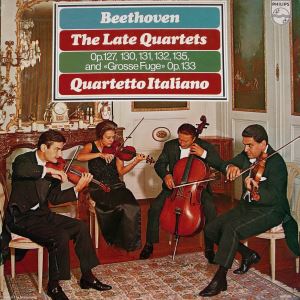
Another example of lovely string tone is Beethoven’s “Grosse Fugue”, Op. 133, originally the finale for String Quartet in B flat, Op. 130, here on a recording by the Quartetto Italiano, also on Philips. The recording space for this performance sounds entirely different from that of the Haydn trio, which points to the Andros not homogenizing the sound of different recordings. While the performance space sounds equally large in terms of ambiance, the performers appear spaced more closely together, with the soundstage not extending beyond the loudspeakers. But the more limited soundstage does not affect tone, which retains a generous but shimmery timbre. The work begins with a staccato opening, then shifts to a somewhat eerie dissonance. Instead of coalescing together, each instrument develops individually, and is easily followed. The viola is featured prominently, with many notes played high on the neck. With a less accomplished phono stage, they could easily become screeching. Not so here. The music slows and becomes less dense, allowing the cello to emerge from the background, though it is a little on the overripe side. In the final section, both the dissonance and tension abate, and for the first time well-defined pizzicato is introduced. The piece ends almost abruptly, though harmoniously. It is easy to hear why what is now known as the Grosse Fugue must have perplexed its original audience in 1827, why it was replaced by a more melodic allegro movement, and why it now stands on its own.
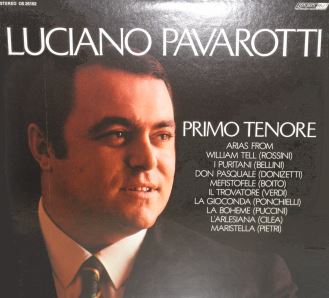
The Zesto Andros PS1 performed equally well with vocals. I put on Luciano Pavarotti’s 1971 collection of opera arias entitled Primo Tenore, which, for an older London recording, has virtually no surface noise, resulting in a nice black background. In A teo o cara from Bellini’s I Puritani, Auturo and Elvira sing of their love for one another on their ill-fated wedding day. Pavarotti’s lyrical tenor is beautifully represented, and Arleen Auger’s seemingly unlimited soprano simply soars. The chorus adds layers of depth to the interchange, and the undercurrent of fulsome pizzicato bass notes resonate satisfyingly. Au verso, in Che gelida manina from Puccini’s La Boheme, Rudolfo, the writer, sings of himself and his dreams to Mimi, whom he has met for the first time, and in less than five minutes, they have fallen in love. Being opera, it doesn’t turn out well. What does turn out well is the Andros’s rendition of Pavarotti’s voice, capturing not only the timbre, but the expressive emotion as well. The fine details of the harp and the woodwinds emerge clearly from the background, and the string tone is liquid.

The sole pop record in my collection is Analogue Production’s new version of Cat Stevens’ Tea for the Tillerman, the inaugural pressing at Chad Kassem’s Quality Record Pressings plant in Selina, Kansas. I have heard this LP many times. What struck me was how full-bodied the music sounded - great bass without being overblown. In Sad Lisa, the keyboards have a strange, warbly sound serving as background for Cat Steven’s voice, which is both rich and lithe, with a little bit of delay to expand the recording space. A close-miked violin with plenty of body interjects mid-way through. It is a thoroughly convincing reproduction. The next song, Miles from Nowhere, provides the distinctive sound of a crisply strummed capoed guitar setting the rhythm. The bass and kick drum are authoritative without being overbearing. Again, Cat Steven’s voice is rich and reverberant. In Into White, a soft-spoken Cat Stevens plays a finely detailed finger-style guitar. Though the potential is there, his vocals evidence no sibilance. In Father and Son, the guitar and drums become prominent, and both are well recorded, with the guitar picked with a thin picked for fast transients. It’s nice to know that the Andros PS1′s strengths are not limited to the dynamics and tonalities of classical music, but are considerably more versatile.
Conclusion
The Zesto Audio Andros PS1 is a wonderful phono stage. It trounces my Musical Surroundings Phonomena II in terms of musicality. The music felt alive, with incredible retrieval of low-level detail. In particular, recording hall ambiance was reproduced with realism, giving the music a “you are there” quality that not even the occasional pop, tick, or bit of groove noise could diminish. The sound was always smooth and well-balanced, with a twinge of warmth, adding bloom to the presentation. Notwithstanding its tube topology, there was no rolling off of the frequency extremes. Given the right recordings, the bass was deep and articulate, and the high frequencies were replete with an ineffable sense of air. The Zesto Audio Andros PS1 clearly deserves all of the accolades it has received, and provides an excellent tool for exploring all the nuances of your vinyl collection. Add my name to the list of admirers.
- Frank Berryman
Contacts
Zesto Audio
3138 Calle Estepa
Thousand Oaks, CA 91360
Telephone: (805) 807-1841
www.zestoaudio.com
[email protected]
Associated Equipment
Analog Source: VPI Scout; Dynavector 20X2; Musical Surroundings Phonomena II
Digital Sources: Meridian G08; Mac Mini; dCS Debussy; Audirvana Plus
Preamplifier: Meridian G02
Power Amplifier: Meridian 557
Loudspeakers: Magnepan 1.7
Analog Cables: Kimber Select KS1016 and KS1116
Digital Cables: Kimber Select KS2020 and KS2416 USB
Speaker Cables: Kimber Select KS6063 and KS9033
Power Cables: Kimber PK10G and PK14G
Headphones: Etymotic ER-4S
Accessories: Audience aR2p power conditioner

